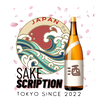I'll talk about sake rice varieties other than Yamada Nishiki that are suitable for sake brewing.
It is said that there are around 100 varieties of sake rice suitable for brewing sake. These sake rice varieties often command prices that are nearly double those of regular table rice due to their specialized qualities.
Below are some of the sake rice varieties used in the sake products featured on this e-commerce site.

** Gohyakumangoku 五百万石 **
Gohyakumangoku rice has large grains, making it challenging to achieve high polishing rates. It is not well-suited for making ginjo or daiginjo sake. However, it is easy to work with for creating the koji mold. Due to its somewhat firm texture and slow dissolution, it tends to produce light and brisk flavors in sake.
** "Hattannishiki No.1 八反錦1号 **
"Hattannishiki No.1" is a sake rice variety with large grains and a substantial shinpaku (starchy center). It yields a refined and elegant aroma profile, resulting in a clean and sophisticated flavor.
** Miyama Nishiki 美山錦 **
Widely cultivated in the Tohoku region of Japan. It tends to result in a light and lively aroma and flavor profile.
** Omachi 雄町 **
"Omachi" is a sake rice variety known for its large grains and high occurrence of shinpaku (starchy center). Its grains have an "Ganjo(eye-shaped)" appearance, which makes it unsuitable for high levels of polishing. Its firm texture and easy solubility contribute to the development of rich and intense aromas and flavors.
** Akita Sake Komachi 秋田酒こまち **
"Akita Sake Komachi" is a suitable sake rice variety produced in Akita Prefecture. It features large grains with a high occurrence of shinpaku (starchy center). Although it has an Ganjo(eye-shaped) appearance, the grains don't grow excessively large, allowing for effective high-level polishing. This rice has the ability to produce a sake with distinct sweetness and umami, while also achieving a light and lively aroma profile.
** Dewa Sansan 出羽燦々 **
"Dewa Sansan" is a recommended sake rice variety from Yamagata Prefecture. It features large grains with a high occurrence of shinpaku (starchy center). Due to its soft texture and easy solubility, it tends to result in a slightly rich and intense aroma profile.
** Kokuryomiyako 穀良都 **
"Kokuryomiyako" is a sake rice variety with large grains and a linear shinpaku(starchy center). It has a low protein content. While it possesses strong disease resistance, its susceptibility to lodging is high due to its long stalks. As "Yamada Nishiki" became more popular, the " Kokuryomiyako " variety, with its long stalks and weaker lodging resistance, faded from prominence. However, in the Heisei era, it has been independently revived in both Yamaguchi and Fukuoka prefectures.
** Senbon Nishiki 千本錦 **
Senbon Nishiki is a sake rice unique to Hiroshima Prefecture. It has large grains with excellent suitability for high polishing, and it also possesses a relatively low amino acid content. This results in a clean and refreshing character while effectively inheriting the aromatic and rich qualities of its parent, Yamada Nishiki. Its distinct characteristics include a fragrant and full-bodied, rounded, and beautiful flavor profile.
